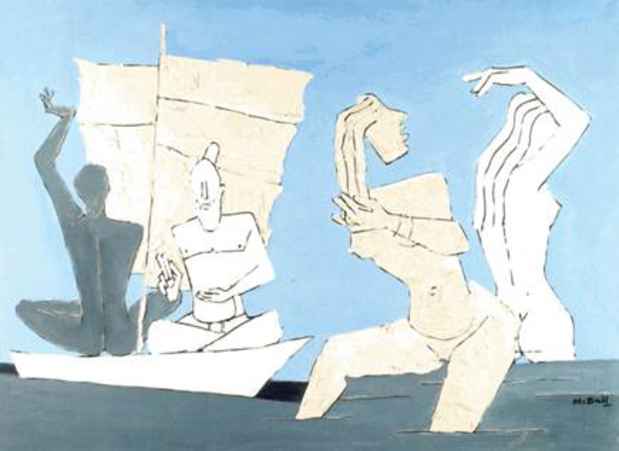"Figure/Landscape – Part One" Exhibition
Aicon Gallery

This event has ended.
Throughout the course of modern Indian art, the dual themes of landscape and the figure, and the interaction between the two, have occupied Indian artists significantly more so than artists working in the Western modernist tradition. In part, this may be traced back to the reluctance by early practitioners of Indian modernism to commit totally to abstraction. Unlike their European counterparts, Indian artists such as M. F. Husain and F. N. Souza, among others, remained committed in their work to figurative references to both landscape and the individual, perhaps as an assertive method through which to impart a unique cultural identity to the their ongoing modernist experiments.
Partha Mitter has argued that the Industrial Revolution in the West, and the subsequent feelings of alienation and angst it bred amongst individuals, helped give rise to the radically distorted and fragmented techniques that became the hallmark of much of European modernism. However, Mitter argues that India, in the first part of the twentieth century at least, was still largely a non-industrial country with a certain level of socio-economic cohesion binding together much of the population. Mitter argues that it was this sense of shared cultural experience, already rapidly disintegrating in Western societies, that shaped the unique paths India’s early modern artists collectively began to explore. The figure of the common man or woman ensconced in a native landscape can then be understood as an articulation of an indigenous modernism, even while its artists continued to draw upon the aesthetics of the broader international discourse. Typical of such a practice is the artist Sudhir Patwardhan's aim, which he described as "to make figures that can become self-images for the people who are the subject of my work.” Or, as Geeta Kapur contends concerning this shared modernist drive in "Contemporary Indian Artists," "the sense of community belongs as much to the past as to the future."
This two-part exhibition, staged in New York and London, aims to explore this prevalence of the figurative in modern Indian art through the presentation of works from across the twentieth-century (and some from the current century). Landscape, the figure and the interplay between them are the pivot points for the project. Some works here appear almost as pure, albeit abstracted, landscapes while others are nearly entirely figurative. Yet a number of works show the figure dissolving into, or functioning almost as a constituent part of the landscape, bringing to light the complex and interdependent relationships that can arise between these two recurring motifs of Indian modernism. The artists in the show include F. N. Souza, M. F. Husain, Jagdish Swaminathan, George Keyt, Jehangir Sabavala, Anjolie Ela Menon, Sudhir Patwardhan and Shyamal Dutta-Ray amongst others.
[Image: M.F. Husain "Ritual of a River" Acrylic on canvas, 27.5 x 38 in.]
Media
Schedule
from October 28, 2010 to November 20, 2010
Opening Reception on 2010-10-28 from 18:00 to 21:00